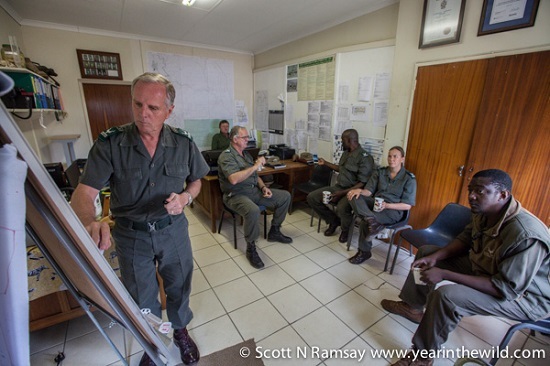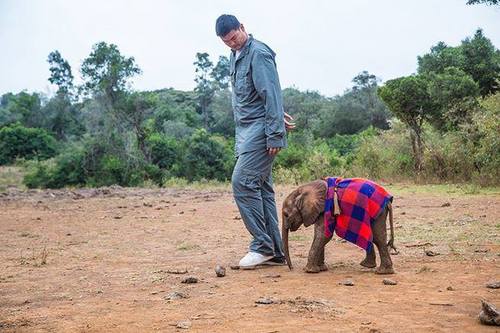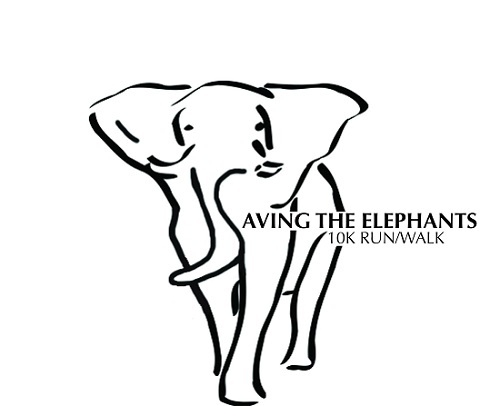With everything else going on in the world right now you might ask why I am writing a blog post about elephants and rhinos. It's because despite everything else filling the news, elephant and rhino poaching is a crisis that needs to be addressed right now. So what is going on and what can you do to help?
Levels of poaching for elephant and rhino are at an all time high and both species face extinction if nothing is done. Between 2010 and 2012 more than 100,000 elephants were lost to poaching, an average of more than 35,000 a year or 10% of the total population. In Tanzania, 30 elephants are killed a day. At this rate, Tanzanian elephants will be gone by 2020. Last year, over 1,000 rhinos were killed in South Africa. As of September this year, over 750 have already been poached. Similar occurrences are taking place across the continent.

Photo Courtesy of David Sheldrick Wildlife Trust
The demand for ivory comes in large part from China where carved ivory is a major status symbol. Both the rise of a middle class in China who can afford to purchase carved ivory and legal sales of ivory stockpiles that occurred in 1999 and 2007 are credited with the increased demand for ivory in China. (The National Geographic Voice for Elephants blog is a great resource for articles on the debate around demand for ivory and elephant poaching in general).
Rhino horn (made of keratin) is particularly valued in Vietnam and Thailand for supposed medicinal properties including curing cancer, asthma and to increase libido. At $65,000 a kilogram rhino horn is the most expensive commodity on Earth, even more than gold and platinum. A rhino is dies every 7 or 8 minutes to support a massive market for what is basically toe-nails and has no medicinal value. Learn more in Dereck Joubert's great article from World Rhino Day.
There is a clear market for these materials, but there is also a lack of knowledge among consumers. A 2007 poll commissioned by the International Fund for Animal Welfare (IFAW) found that 70 percent of the Chinese did not know that ivory comes from dead elephants. And while it is possible to remove a rhino horn without killing the animal, this is not happening in practice for poached animals and this is equally misunderstood by populations in consuming countries. This means that education and advocacy to reduce demand for ivory and rhino horn is an essential part of the anti-poaching battle. Organizations like WildAid are working to reduce demand in consuming countries like China with Chinese celebrities including Yao Ming and actress LiBingBing.
So who is responsible for the poaching itself? There is ample evidence that those at the top of the poaching food chain are part of organized international criminal syndicates. According to the Stimson Center, a Washington DC think tank, "the spike in poaching and wildlife crime coincides with the increased involvement of sophisticated transnational organized criminals and terrorist organizations." Al-Shabab, the al-Qaeda affiliate that carried out the attack on Nairobi's Westgate Mall, now reportedly generates over 40% of its revenue from illicit ivory sales. Read more about the connection between ivory and terrorism here.
In contrast, individual poachers tend to be uneducated locals who are struggling to find work and feed their families. They see an opportunity to make what can amount to more than a year's salary in a few days and they take it. Arresting poachers and discouraging them with shoot-to-kill policies, high fines and prison terms are an important element of combating poaching but finding the higher-ups will stop poaching at the source. This requires intelligence, resources, and unified government initiatives.

Photo Courtesy of Scott Ramsay. Find his interview with Kruger's anti-poaching chief General Johan Jooste on his website Year in the Wild.
What are the implications of the potential extinction of elephant and rhinoceros? Aside from the obvious, a sad and totally unacceptable end to these iconic species, the disappearance of rhinos and elephants from Africa would have serious economic consequences for the continent. Wildlife is what brings people on safari. If there is no wildlife to see, people will not come. If people do not come, essential revenue and jobs will be lost. For example, tourism accounts for almost 13% of Tanzania's GDP and directly employs over 400,000 people. A lack in tourism would cause severe economic damage.
So what can you do?
The upside to all of these is that one of the best things you can do to combat rhino and elephant poaching is go on safari! Many properties, private reserves and concessions are actively engaged conservation and in anti-poaching efforts and tourism dollars go to support those initiatives. In addition, when tourism generates revenue for local communities and the national economy, it justifies the existence of wilderness areas and creates local conservation advocates.
All of the properties I work with in Africa emphasize this local support as essential to combating poaching, local eyes and ears are the key to catching poachers before a rhino or elephant is dead. All of this means that the dollars you spend on safari help to support conservation and combat poaching on multiple fronts, and you get to have a once in a lifetime experience! (Please note that if you are on safari and take a picture of an elephant or a rhino do not post it with a location on social media; poachers use real time social media data to locate animals)
- Big Life Trust funds and coordinates independent anti-poaching teams in the Amboseli ecosystem that runs between southern Kenya and northern Tanzania. They also provide protection to some of the last black rhinos in Kenya's Chyulu Hills.
- Zeros for Rhinos/Rhinos without Borders is an initiative by the Great Plains Foundation and &Beyond to relocate 100 rhinos under pressure from poaching from South Africa to the relative safety of Botswana.
- Donate to S.A.F.E (Safe-Guarding Future for Africa's Elephants) which divides funding among several excellent anti-poaching organizations including Save the Elephants and the David Sheldrick Wildlife Trust.
Run!
For all those runners in New York, come participate in the Saving the Elephants 10k Run/Walk in Central Park on Saturday, November 22 to raise money for the David Sheldrick Wildlife Trust. Almost 400 people have already registered! Register and join the Extraordinary Journeys team or donate. Get more information here on what the day will look like.
I hope to see you there!




